Tables 8, 9, and 10 present a toolbox of common engineering countermeasures that may be used to address non-motorized safety issues on rural roads. This list is not comprehensive; it is intended to provide general guidance on typical countermeasures. Each countermeasure in the tables includes the following information:
- Measure - A list of potential rural countermeasures that are applicable along the road, at crossings, or for traffic calming.
- Description - A brief description of the countermeasure.
- Application - Generally how or when to use the countermeasure. Includes when to use it on rural roads (RR) or rural villages (RV).
- Cost - The approximate cost of the countermeasure, with a range of low to high. Low-cost countermeasures are generally associated with items that do not involve construction, such as applying signing and pavement markings. Medium-cost countermeasures generally require some construction, while high-cost measures require extensive construction.
- Crash Modification Factor (CMF) - The measure of the effectiveness of a particular countermeasure, measured by the percentage of crashes it is expected to reduce. For example, shoulders provide space along the edge of the road for pedestrians, bicyclists, and horse-drawn vehicles. The CMF for shoulders is 0.63, meaning that crashes associated with the lack of shoulder space (e.g., walking, biking, or riding) alongside the road can be expected to decrease by 36 percent if shoulders are provided. Unless otherwise noted, CMFs can be found in the CMF clearinghouse (http://www.cmfclearinghouse.org). However users should consult the original publication to determine applicability to their particular scenario.
- Illustration - A depiction or photograph of the countermeasure described.
Crash Modification Factors
A tool to aid in the countermeasure selection process is the CMF Clearinghouse. This online application is a database of CMFs and supporting documentation to help users identify the most appropriate countermeasures to address safety needs. (http://www.cmfclearinghouse.org/)
Table 8. Roadway Measures
| Measure | Description | Application† | |
|---|---|---|---|
| Signage: Regulatory | |||
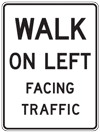 |
Walk on Left Facing Traffic Signs(1,6) Cost: Low CMF**: (UNK) |
Signs directing pedestrians to walk on the left side of the roadway to face traffic (MUTCD R9-1). | To be used on roads where there are no parallel sidewalks or shared use paths. |
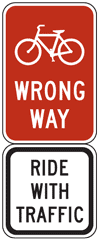 |
Bicycle Wrong Way and Ride with Traffic Signs(1,6) Cost: Low CMF**: (UNK) |
Signs informing cyclists that they are traveling the wrong way and directing cyclists to ride in the same direction as motorized vehicles (MUTCD R5-1b and R9-3cP). | To be used on roads where there are no available shared use paths. |
 |
Bicycles May Use Full Lane Signs(1,6) Cost: Low CMF**: (UNK) |
Signs indicating that cyclists may occupy the travel lane (MUTCD R4-11). | To be used on roads where there are no bicycle lanes or usable shoulders and where marked travel lanes (should not be used on undivided, unmarked roadways) are too narrow for cyclists and motor vehicles to operate side-by-side. May be used in addition to or instead of the Shared Lane Marking. |
| Signage: Warning | |||
 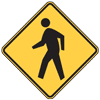 |
Vehicular and Non-Vehicular Warning Signs(1,6) Cost: Low CMF**: (UNK) |
Signs warning motorists of unexpected entries into the roadway or to alert motor vehicles that they are sharing the roadway with bicycles, pedestrians, farm equipment, and horse-drawn vehicles (multiple signs; MUTCD Figures 2C-10 and 2C-11). A fluorescent yellow-green background color may be used for pedestrian and bicycle waning signs and accompanying plaques. | To be used on sections of roadway with unexpected path, trail, or roadway intersections (see Table 9, Vehicular and Non-Vehicular Warning Signs) when driver sight distance is limited; or in sections where motor vehicles commonly share the road with other forms of transportation. |
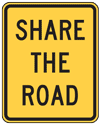 |
Share The Road Plaques(1,6) Cost: Low CMF**: (UNK) |
Signs warning motorists to share the roadway with slower forms of transportation, such as bicycles, pedestrians, or horse-drawn vehicles (MUTCD W16-1P). | To be used in combination with vehicular or non-vehicular warning signs. |
| Pavement Markings | |||
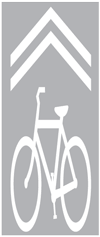 |
Shared Lane Markings(6) Cost: Low CMF**: (UNK) |
A pavement marking symbol (also known as a SLM or "Sharrow") that warns motorists of the presence of cyclists and assists cyclists with lateral positioning in lanes that are too narrow for a motor vehicle and a bicycle to travel side-by-side within the same traffic lane (Section 9C.07 of the MUTCD). | Used to assist bicyclists with lateral lane positioning (should not be used on undivided, unmarked roadways) that are too narrow for a motor vehicle and a bicycle to travel side-by-side within the same lane; alert road users of the lateral location bicyclists within the lane; encourage safe passing of cyclists by motorists; and reduce t wrong-way bicycling. The SLM should not be used on roadways posted above 35 mph. The SLM may be used in addition to/instead of the Bicycles May Use Full Lane. |
| Physical Environment | |||
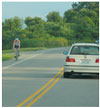 |
Paved Shoulders(2), 4-8’ Cost: High CMF**: 0.29(7) (V) (P) |
Dedicated space along the roadway that may accommodate bicycles, pedestrians, horse-drawn vehicles, and stopped motor vehicles in emergency, depending upon roadway characteristics, such as cross section, speed of vehicles in adjacent travel lane, and conflicts on shoulder. | To be used in areas where pedestrian, bicycle, and/or horse-drawn vehicle volumes and motor vehicle volumes and speeds combine to create the need for separated space along the roadway. |
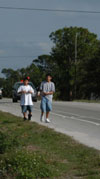 |
Separated Shoulders Cost: Low for restriping existing paved shoulder; High for constructing new paved shoulder CMF**: 0.29(7) (V) (P) |
A paved shoulder that is separated by a pavement marking to create a buffer from the vehicle travel lanes. The buffer space may be marked with diagonal pavement markings and ranges from 1 to 4 feet wide. | To be used in areas where pedestrian, bicycle, and/or horse-drawn vehicle volumes and motor vehicle volumes and speeds combine to create the need for separated and buffered space along the roadway. |
 |
Bike Lanes(3) Cost*: Varies CMF**: 0.65(8) (V) (B) |
A lane in the roadway designated for bicycle use through the use of striping, signing, and pavement markings (MUTCD Chapter 9B and 9C). | To be used in areas with high volumes and speeds of motor vehicles and bicycles. (RV) |
 |
Sidewalks and Walkways(4) Cost: Medium to High CMF**: 0.11 - 0.35(7) (V) (P) |
Pedestrian facilities that are separated from the roadway. Can be made of asphalt, concrete, or crushed stone. Sidewalks are usually paved and separated from the street by curbing. Pedestrian walkways may be separated from the roadway with a physical barrier or a landscaped strip. | To be used in areas with a high volume of pedestrians and high motor vehicle speeds or in areas where on-road bicycle/pedestrian travel is prohibited. (RV) |
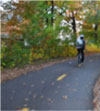 |
Shared Use Paths(4) Cost: Medium to High CMF**: 0.12 - 0.35(7) (V) (P) |
A facility separated from motorized vehicular traffic by a landscaped space or barrier. Shared use paths may be used by cyclists, pedestrians, skaters, wheelchair users, joggers, and other non-motorized users. Such facilities are often referred to as "trails."(5) | To be used in areas with a high volume of pedestrians and bicyclists and high motor vehicle speeds or volumes. |
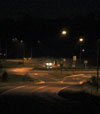 |
Roadway Illumination(5) Cost: Medium CMF**: 0.27 - 0.8(9) (R) |
Lighting directed to illuminate the roadway. | To be used on sections of roadway with a high volumes of nighttime non-motorized activity. (RV) |
| Roadway Surface Improvements Cost: Maintenance: low Paving/ repaving: high CMF**: Varies greatly based on conditions present |
Roadway surface improvements include maintenance and paving activities to provide a smooth and slip-resistant traveling surface for pedestrians and cyclists. | Facilities used by pedestrians and cyclists should be smoother than those deemed acceptable for motorized traffic to maintain stability. Therefore it is important that debris be cleared from facilities used by pedestrians and cyclists. If rumble strips are present, sufficient gaps should be provided for cyclists to move from the shoulder to the travel lane. Additionally, there should be sufficient width for cyclists to ride between the edge of the rumble strip and the edge of the shoulder. | |
| † Legend: (RR)=Rural Road, (RV) = Rural Village * Measures may vary greatly in cost. For example, some measures may be achieved through redistribution of space on the current roadway or it may require expansion of the roadway. ** CMF’s are based upon all crash types unless otherwise noted. Notations for other crash types may include: (V)=motorized vehicles, (B)=bicycles, (P)= pedestrians, or location information (R)=rural. For those CMF’s that are unknown, (UNK) = Unknown. Unless otherwise noted, CMFs can be found in the CMF clearinghouse (http://www.cmfclearinghouse.org). However users should consult the original publication to determine applicability to their particular scenario. 1. Federal Highway Administration. (2009). Manual on Uniform Traffic Control Devices. Washington, D.C.: Federal Highway Administration. 2. ITE Committee 5A-5. (1998). Design and Safety of Pedestrian Facilities. Washington, D.C.: Institute of Transportation Engineers. 3. American Association of State Highway Safety Officials. (1999). Guide for the Development of Bicycle Facilities. Washington, D.C.: American Association of State Highway Safety Officials. 4. Federal Highway Administration. (2008). Guidance Memorandum on Consideration and Implementation of Proven Safety Countermeasures. Retrieved August 29, 2011, from Federal Highway Administration. 5. Hall, J. W., Brogan, J. D., & Kondreddi, M. (2004). Pedestrian Safety on Rural Highways. FHWA-SA-04-008. Washington, D.C.: Federal Highway Administration. 6. Overuse of signs and pavement markings may reduce their effectiveness. These devices should be used in locations where the needs are greatest. 7. Gan, A., Shen, J., and Rodriguez, A., "Update of Florida Crash Reduction Factors and Countermeasures to Improve the Development of District Safety Improvement Projects." Florida Department of Transportation, (2005). 8. Rodegerdts, L. A., Nevers, B., and Robinson, B., "Signalized Intersections: Informational Guide." FHWA-HRT-04-091, (2004). 9. Elvik, R. and Vaa, T., "Handbook of Road Safety Measures." Oxford, United Kingdom, Elsevier, (2004). |
|||
Table 9. Crossing Measures
| Measure | Description | Application† | |
|---|---|---|---|
| Signage: Regulatory | |||
 |
Traffic Signal Pedestrian and Bicycle Actuation Signs(1) Cost: Low CMF**: (UNK) |
Signs directing pedestrians and bicyclists to use push buttons at signalized intersections (MUTCD Figures 2B-26 and 9B-2). | To be placed immediately above or incorporated into push button detector units. |
 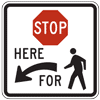 |
Yield to/Stop for Pedestrians(1,7) Cost: Low CMF**: (UNK) |
Signs directing drivers to yield/stop at yield (stop) lines used in advance of a marked crosswalk (R1-5a, b, and c- MUTCD Figure 2B-2). | To be used before a crosswalk on an uncontrolled, multilane approach. Stop for Pedestrian sign can only be used where the law specifically requires drivers to stop for pedestrians in a crosswalk. |
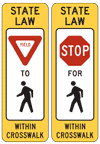 |
In-Street Pedestrian Crossing Signs(1,7) Cost: Low CMF**: (UNK) |
Signage, also known as Pedestrian Knockdown Signs, that is placed in the roadway alerting roadway users of pedestrian crossings (MUTCD R1-6 or R1-6a). If struck by a vehicle, the signs are designed to bend over and bounce back. | For use on low-speed roadways, specifically on the centerline, a lane line, or an island, at an unsignalized pedestrian crossing. Stop message can only be used where the law specifically requires drivers to stop for pedestrians in a crosswalk. |
 |
Side-of-Street Pedestrian Uncontrolled Crosswalk Signs(7) Cost: Low CMF**: (UNK) |
As an alternative to the in-street pedestrian knockdown sign, some agencies have developed a side-of-street sign. This sign is a modified version of the R1-6a for use on the side of the road and is not found in the MUTCD. Approval for experimentation would need to be obtained from FHWA. For more information on experimental devices, refer to Section 1A.10 of the 2009 edition of the MUTCD. | To be used before a crosswalk on an uncontrolled, multilane approach. Stop message can only be used where the law specifically requires drivers to stop for pedestrians in a crosswalk. May be accompanied by Advance Stop/Yield signs. |
| Signage: Warning | |||
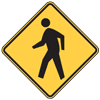 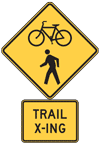 |
Vehicular and Non-vehicular Warning Signs(1,7) Cost: Low CMF**: (UNK) |
Signs warning drivers of unexpected entries into the roadway or to alert drivers that they are sharing the roadway with bicycles, pedestrians, farm equipment, and horse-drawn vehicles (MUTCD Figures 2C-10 and 2C-11). A fluorescent yellow-green background color may be used for pedestrian and bicycle warning signs and accompanying plaques. | To be used where paths, trails, or roads intersect in unexpected locations, when the driver’s sight distance is limited, or in sections where motor vehicles commonly share the road with other forms of transportation (see Table 8, Vehicular and Non-Vehicular Warning Signs). Signs may be placed in advance,at a crossing, or both. If placed at a crossing, a diagonal downward pointing arrow (W16-7P) plaque (see Figure 2C-12) shall be mounted below the sign. |
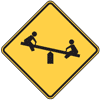 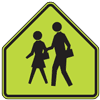 |
Playground, School Warning, and School Crossing Signs(1,7) Cost: Low CMF**: (UNK) |
Signs that warn motorists of a playground; school property, buildings, or crossing guards; and/or a designated school zone (MUTCD W15-1 and Figure 7B-1). School crossing and advanced school crossing signs are similar to pedestrian crossing signs, only they warn motorists of a school crossing. | Signs should be placed in advance of and at playgrounds, schools, school zones, and school crossings. |
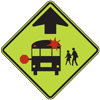 |
School Bus Stop Warning Signs(1,7) Cost: Low CMF**: (UNK) |
Signs that are used in advance of bus stops (MUTCD S3-1). | Signs should be placed in advance of bus stops when motorists do not have adequate site distance and the bus stop cannot be moved. |
| Pavement Markings | |||
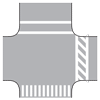 |
Crosswalks(2,5) Cost: Varies Low: Markings only; Moderate: Markings and simple ADA landings; High: Significant pedestrian safety features required CMF**: 0.4 - 0.75(2,5) (V) (P) (R) |
Pavement markings delineating a portion of the roadway that is designated for pedestrian or bicycle crossing. There are several types including: continental, zebra, and standard (MUTCD Section 3B.18). | To be used at intersections or midblock crossings. Crosswalks may be used in areas with lower traffic volumes, lower speeds, and a limited number of travel lanes. See Safety Effects of Marked vs. Unmarked Crosswalks at Uncontrolled Locations for additional guidance regarding when to install a marked crosswalk.(3) |
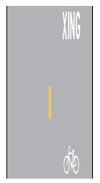 |
XING Markings(1,5) Cost: Low CMF**: (UNK) |
Pavement markings that provide emphasis to pedestrian and bicycle crossings (MUTCD Section 3B.20). | To be used as a supplement to regulatory and warning pedestrian and bicycle crossing signs. |
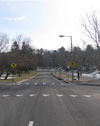 |
Advance Yield/Stop Lines(1,5) Cost: Low CMF**: (UNK) |
Pavement markings used at crosswalks as a supplement to a Yield Here to/Stop for Pedestrians sign. | To be used before a crosswalk and in combination with a Yield Here to/Stop for Pedestrian Sign. However, it should not be used in conjunction with a roundabout (MUTCD Figure 3B-17). |
| Physical Environment | |||
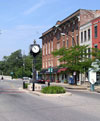 |
Median Crossing Islands(3) Cost: Medium CMF**: 0.54 - 0.61(7) (V) (P) |
A raised island in the center of the roadway with a refuge area that is accessible for pedestrians of all abilities. Can also provide a refuge area for cyclists, especially at locations where a shared use path crosses a roadway. The island allows pedestrians and cyclists to cross one direction of traffic at a time. | To be used when pedestrians and cyclists have to cross high-volume, multilane roadways (MUTCD Chapter 3I). (RV) |
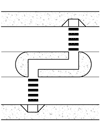 |
Staggered Median Islands(4) Cost; Medium CMF**: 0.54 - 0.61(7) (V) (P) |
A raised island located in the center of the roadway where the crosswalk is offset through the median island. The pedestrian crossing on the island is fenced and directs pedestrians to face oncoming traffic while crossing the median. | For use on high-volume or high-speed roadways so pedestrians are directed to face traffic before crossing. (RV) |
 |
Pedestrian Hybrid Beacons(1,5) Cost: High CMF**: 0.309 (V) (P) - 0.712(8) |
This device is one of the new FHWA Proven Safety Countermeasures and is used to warn and control traffic at an unsignalized location to assist pedestrians in crossing a street or highway at a marked crosswalk (MUTCD Chapter 4F). The device consists of three signal sections, with a yellow signal head centered below two horizontally aligned red signal heads. | For use at midblock crossings and intersections that do not warrant a signal. |
 |
Rectangular Rapid Flash LED Beacons(4,6) Cost: Medium CMF**: (UNK) |
A beacon that provides a warning to motorists about the presence of a crosswalk. Beacon is yellow, rectangular, and has a rapid "wig-wag" flash similar to police lights. Beacon should operate only when a pedestrian is present; utilize either push button or passive detection. | For use at midblock crossings and intersections that do not warrant a signal. |
 |
In-roadway warning lights at crosswalk(1) Cost; Medium CMF**; (UNK) |
Amber flashing lights embedded in the pavement on both sides of a crosswalk and oriented to face oncoming traffic, these serve as a warning for motorists when a pedestrian is in the crosswalk. The amber LED lights flash in unison and are visible during the daylight, as well as at night. | For use at midblock crossings and intersections that do not warrant a signal. |
| † Legend: (RR)=Rural Road, (RV) = Rural Village * Measures may vary greatly in cost. For example, some measures may be achieved through redistribution of space on the current roadway or it may require expansion of the roadway. ** CMF’s are based upon all crash types unless otherwise noted. Notations for other crash types may include: (V)=motorized vehicles, (B)=bicycles, (P)= pedestrians, or location information (R)=rural. For those CMF’s that are unknown, (UNK) = Unknown. Unless otherwise noted, CMFs can be found in the CMF clearinghouse (http://www.cmfclearinghouse.org). However users should consult the original publication to determine applicability to their particular scenario. 1. Federal Highway Administration. (2009). Manual on Uniform Traffic Control Devices. Washington, D.C.: Federal Highway Administration. 2. ITE Committee 5A-5. (1998). Design and Safety of Pedestrian Facilities. Washington, D.C.: Institute of Transportation Engineers. 3. American Association of State Highway Safety Officials. (1999). Guide for the Development of Bicycle Facilities. Washington, D.C.: American Association of State Highway Safety Officials. 4. Federal Highway Administration. (2008). Guidance Memorandum on Consideration and Implementation of Proven Safety Countermeasures. Retrieved August 29, 2011, from Federal Highway Administration: http://safety.fhwa.dot.gov/provencountermeasures/pc_memo.cfm. 5. Hall, J. W., Brogan, J. D., & Kondreddi, M. (2004). Pedestrian Safety on Rural Highways. FHWA-SA-04-008. Washington, D.C.: Federal Highway Administration. 6. Overuse of signs and pavement markings may reduce their effectiveness. These devices should be used in locations where the needs are greatest. 7. Gan, A., Shen, J., and Rodriguez, A., "Update of Florida Crash Reduction Factors and Countermeasures to Improve the Development of District Safety Improvement Projects." Florida Department of Transportation, (2005). 8. Rodegerdts, L. A., Nevers, B., and Robinson, B., "Signalized Intersections: Informational Guide." FHWA-HRT-04-091, (2004). |
|||
Table 10. Speed Reduction Measures
| Measure | Description | Application† | |
|---|---|---|---|
| Signage | |||
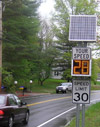 |
Speed Feedback Signs(1,7) Cost: Low CMF**: 0.54(8) |
A changeable message sign that displays the speed of approaching vehicles. | To be used where motorized vehicle speed is a concern. |
| Pavement Markings | |||
 |
Speed Reduction Markings(1,7) Cost: Low CMF**: (UNK) |
Pavement markings that are located on either side of the travel lane and are perpendicular to the centerline and edgelines. They are progressively spaced at shorter distances to give motorists the illusion of traveling at a faster speed (MUTCD Figure 3B-28). | To be used in locations where slower speeds are required. Can only be used on roadways with both centerline and edgelines. Not effective on areas with primarily local drivers. |
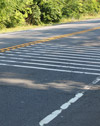 |
Roadway (or Transverse) Rumble Strips Cost: Low CMF**: 0.76(9) (R) |
Raised bars or grooves placed across the travel lane that can be either black or white. | To be used to alert drivers of the need to reduce speed in locations where other measures cannot be applied or have been tested and have not succeeded in addressing speeding issues. Bicyclist (and motorcyclist) concerns should be addressed by a break in the strips and installing a warning sign reading "RUMBLE STRIPS AHEAD." May have limited use because of citizens concerns over noise from vehicles driving over. |
 |
Lane Narrowing Cost: Low CMF**: Varies(10) |
The narrowing of travel lanes—either visually (by using pavement markings) or physically narrowing (with measures such as curb extensions). One example of visually narrowing lanes is a painted island that is an island defined by pavement markings and created with the function of reducing lane widths for traffic calming purposes.(3) | For use in areas with wide travel lanes and where speed is a concern (MUTCD Chapter 3I). |
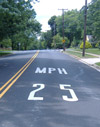 |
Regulatory Pavement Markings(3) Cost: Low CMF**: (UNK) |
Pavement markings, such as "25 MPH", that emphasize regulatory signage (MUTCD Section 3B.20). | To be used as a supplement to regulatory signs. |
| Physical Environment | |||
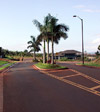 |
Gateways(1) Cost: Low – High CMF**: (UNK) |
Visual or physical markers to serve as an indicator to motorists that they are entering an urbanized area and to slow down. | For use at the entrance of a residential or commercial area. |
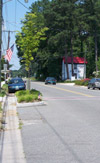 |
Curb Extensions(1) Cost: Medium CMF**: 0.63(11) |
Also known as bulb-outs or neckdowns, curb extensions are portions of the roadway where the curb extends out into the parking lane. This both visually and physically narrows the roadway to reduce vehicle speeds, it allows pedestrians and motorists to better see each other, and it provides a shorter distance for pedestrian crossings. | To be used on sections of roadway where on-street parking is provided, there are high motor vehicle speeds, and pedestrian crossings are common. |
 |
Lane Narrowing(4) Cost: Medium – High CMF**: Varies by width |
The physical narrowing of lane widths. Can also be achieved through pavement markings (see above). | For use in areas with wide travel lanes and where speed is a concern. |
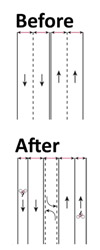 |
Road Diets(5) Cost: Low-Medium CMF**: 0.47(12) - 0.71(13) (S) (U) |
A redistribution of space in the roadway leading to a reduction in the number of travel lanes for motor vehicles on a roadway. The road diet is one of FHWA’s Proven Safety Countermeasures and may provide space for bike lanes, sidewalk, or medians, and can help to reduce motor vehicle speed. | For use in areas with pedestrian crossings, multiple lanes of traffic, and high vehicle speeds. |
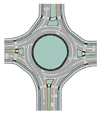 |
Roundabouts(6) Cost: Low - High CMF**: 0.29(14) - 0.42(15) |
A type of intersection form that is characterized by a generally circular shape, yield control on entry, and raised geometric features, including splitter islands and a center island, that together create a low-speed, efficient environment. Roundabouts are included in the FHWA Proven Safety Countermeasures. | For use at intersections where speed is a concern and/or where intersection congestion, delay or safety have worsened. Roundabouts are highly customizable, ranging from simple minis (small footprint) to complex multilane (large footprint), and can accommodate a wide range of intersection conditions. |
| † Legend: (RR)=Rural Road, (RV) = Rural Village, * Measures may vary greatly in cost. For example, some measures may be achieved through redistribution of space on the current roadway or it may require expansion of the roadway. ** CMF’s are based upon all crash types unless otherwise noted. Notations for other crash types may include: (V)=motorized vehicles, (B)=bicycles, (P)= pedestrians, or location information (R)=rural. For those CMF’s that are unknown, (UNK) = Unknown. Unless otherwise noted, CMFs can be found in the CMF clearinghouse (http://www.cmfclearinghouse.org). However users should consult the original publication to determine applicability to their particular scenario. 1. Federal Highway Administration. (2009). Engineering Countermeasures for Reducing Speeds: A Desktop Reference of Potential Effectiveness. Washington, D.C.: Federal Highway Administration. 2. Federal Highway Administration. (2008). Traffic Calming on Main Roads Through Rural Communities. FHWA-HRT-08-067. 3. Federal Highway Administration. (2009). Manual on Uniform Traffic Control Devices. Washington, D.C.: Federal Highway Administration. 4. Federal Highway Administration. PedSAFE: Pedestrian Safety Guide and Countermeasure Selection System. Retrieved August 29, 2011, from Pedestrian and Bicycle Information Center: http://www.walkinginfo.org/pedsafe/ 5. National Center for Safe Routes to School. Safe Routes to School Guide. Retrieved August 29, 2011, from National Center for Safe Routes to School: http://guide.saferoutesinfo.org/ 6. Federal Highway Administration. BikeSAFE: Bicycle Countermeasure Selection System. Retrieved August 29, 2011, from Pedestrian and Bicycle Information Center: http://www.bicyclinginfo.org/bikesafe/ 7. Overuse of signs and pavement markings may reduce their effectiveness. These devices should be used in locations where the needs are greatest. 8. Elvik, R. and Vaa, T., "Handbook of Road Safety Measures." Oxford, United Kingdom, Elsevier, (2004). 9. Liu, P., Huang, J., Wang, W., Xu, C., "Effects of Transverse Rumble Strips on Safety of Pedestrian Crosswalks on Rural Low-Volume Roads in China." Presented at the 90th Meeting of the Transportation Research Board, Washington, D.C., (2011). 10. Hauer, E., "Lane Width and Safety." (2000). 11. Institute of Transportation Engineers, "Toolbox of Countermeasures and Their Potential Effectiveness to Make Intersections Safer." Briefing Sheet 8, ITE, FHWA, (2004). 12. Persaud, B., Lana, B., Lyon, C., and Bhim, R. "Comparison of empirical Bayes and full Bayes approaches for before–after road safety evaluations." Accident Analysis & Prevention, Vol. 42, Issue 1, pp. 38-43 (2010). 13. Harkey, D.L., R. Srinivasan, J. Baek, B. Persaud, C. Lyon, F.M. Council, K. Eccles, N. Lefler, F. Gross, E. Hauer, J. Bonneson, "Crash Reduction Factors for Traffic Engineering and ITS Improvements", NCHRP Project 17-25 Final Report, Washington, D.C., National Cooperative Highway Research Program, Transportation Research Board, (2008). 14. Rodegerdts, L. A., Blogg, M., Wemple, E., Myers, E., Kyte, M., Dixon, M., List, G., Flannery, A., Troutbeck, R., Brilon, W., Wu, N., Persaud, B., Lyon, C., Harkey, D., and Carter, D., "NCHRP Report 572: Applying Roundabouts in the United States." Washington, D.C., Transportation Research Board, National Research Council, (2007). 15. Persaud, B. N., Retting, R. A., Garder, P. E., and Lord, D., "Observational Before-After Study of the Safety Effect of U.S. Roundabout Conversions Using the Empirical Bayes Method." Transportation Research Record, No. 1751, Washington, D.C., Transportation Research Board, National Research Council, (2001). |
|||
